Teething Remedies
In the past, the process of teething was thought to be downright life-threatening and many of the attempted teething “remedies” were highly barbaric.
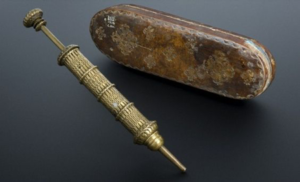
In the ancient world (and up through the 1600s), medicine men advised parents to use hare’s brain – yes, hare’s brain – to treat teething, either by rubbing it on babies’ gums or serving it up for dinner.
Yum.
How’s this for sound medicine: From the 1500s through the 1800s, teething babies were treated to lancing – yes, having their gums slashed with a lancet (a sharp, surgical-esque bladed knife). This protocol was almost universal.
In the modern era, medications, homeopathy, and witchcraftery have been favorite courses of action, ranging from treatments containing opium, morphine, mercury, lead, analgesics and hard alcohol.
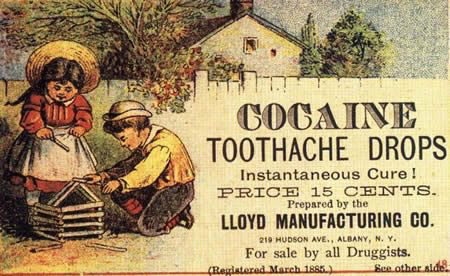
Unfortunately (and frustratingly!), the evidence on how to best deal with teething is “entirely lacking.” (WTF?) There certainly is no magic bullet, but here’s a run-down of some of the most popular teething remedies used these days, including a few that aren’t recommended.
Like with most things parenting-related, it will probably take everyone some amount of trial-and-error to see what works best. Here goes —
The Safest Bets for Teething Remedies
Hands down, the optimal teething remedy involves cold pressure. Experts suggest having babies chew on cool, hard objects (stored in the fridge as opposed to the freezer).
The child gets relief from both the cold temperature (the vasoconstriction decreases inflammation) and from the act of chewing, because it applies pressure to the sore area.
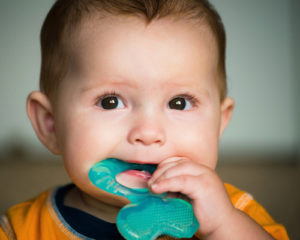
There are tons of different options as far as the actual object goes, and different items work well for different kids and for different teeth. Here are some great possibilities to try at home (some of which came from you, Dear Readers) —
Teething Remedies
- Teething rings (see our favorites) — solid rings are preferred so they don’t rupture and leak everywhere (or become ingested)
- Chilled/refrigerated pacifiers
- Cold spoons
- Cold, damp washcloths
- Frozen fruit or veggies: Try peeled cucumber, large peeled carrots (a whole carrot), banana, mango – just make sure the food you choose doesn’t pose a choking risk (this will vary by age and stage in the overall teething process)
- Cold or frozen fruit in a mesh feeder
- Frozen waffles or pancakes
- Nursing often
- some experts recommend administering gum massage – literally rubbing your baby’s gums
- Snuggles (seriously… one study in Iran actually found that cuddle therapy was associated with improved teething symptoms)
Pain Relief
Though a few pediatricians and dentists advise against the uses of oral ibuprofen (Advil) and acetaminophen (Tylenol) to help relieve teething pain, most are perfectly comfortable with the medications as long as parents use them according to the directions and in moderation. Note: Advil should only be used in babies that are at least 6-months-old, and dosages for both medications should be confirmed with your pediatrician.
To recap, your best bets for teething remedies include: cold pressure (see the best teethers), gum massage (not as popular), and OTC pain medications, with caveats.
Tips for Handling Biting while Nursing
It’s not uncommon for expectant moms to say they only want to nurse until their baby starts teething. The thought of being bitten by your baby on the milk-makers is terrifying (and pain-inducing)! But remember this: most babies in history were nursed welllll into toddlerhood (and many times, beyond), so don’t be afraid. You’ve come this far, don’t get deterred by a little biting.
That said, I get it; it’s scary! I remember when my teething baby latched and all I could see was an image of Jaws coming at my poor, vulnerable nipple. But, if you can survive the vampire-like latch of a hungry newborn, you can get through this too.
Maybe this will help: a baby who is actively nursing cannot simultaneously bite you. Biting usually only becomes a problem when your baby is done nursing and has entered play-mode.
Generally speaking, the strategies for eliminating biting during breastfeeding fall into two categories: preemptive and reactive.
Preventative
To prevent biting before it happens, pediatricians recommend giving the baby something cold to chew on, or rubbing her gums right before a nursing session. To this end, you could try out any number of the general teething strategies from the list above.
Reactive
The reactive strategies are all about behavioral conditioning. The idea is to teach your baby, through your response, that biting is not okay.
As far as how to react to a bite, it’s sort of a Goldilocks situation. The idea is to communicate to your baby that biting hurts and is unacceptable, but without overdoing it.
Of course, it’s near-impossible not to react if you’re bitten. Apparently, too harsh of a response (i.e., yelling too loudly) could scare the baby and bring on a “nursing strike.”
The perfect level of response will probably only become clear through trial-and-error – one baby might get the hint from a firm “no!” or “ouch!” while another might think it’s amusing and try to elicit the reaction again.
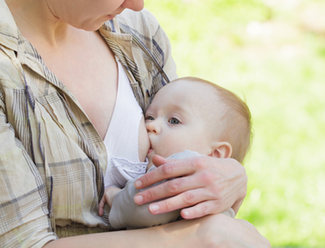
Alternatively, lactation counselor Kelly Bonyata (from the wonderful breastfeeding resource kellymom.com) notes, “it can be very effective to calmly remove the baby from the breast and say nothing… then end the nursing session for a bit.” Bonyata also stresses that “stopping the nursing session is generally the most effective way to teach baby that nursing and biting do not go together.”
For anyone who wants to take firmer action or go a step further, La Leche League suggests pulling the baby off the breast, then promptly placing the baby on the floor and letting her experience a few moments of distress. After several seconds, you can then offer comfort; this should help teach the baby that “biting brings negative consequences.” Dr. Sears also sanctions this pull-off-and-put-down technique. “Don’t do this in any punitive way,” he notes – “just let her know with your body language that biting means the end to nursing.”
One final tip might sound counterintuitive: if baby bites, push her in closer to your breast, rather than pulling her away. This momentarily blocks the baby’s nose (and airway), forcing her to release from a bite. Some mothers have noted great success with the “pulling in” strategy, because it teaches baby that biting always gets this response.
Treatment Options to Avoid
Here are some popular products to think twice about — and why. Yes, you’ll hear many, many moms tout these remedies – and that’s okay – but here’s the full picture so you can make a decision for yourself.
Topical Teething Gels
Though between 25% and 75% of parents around the world report using teething gels, they are not without risk. Many pediatricians and pediatric dentists explicitly advise against them, and for good reason.
For starters, there’s no good evidence that any of these gels work. More importantly, though, they are potentially hazardous. The Food and Drug Administration (FDA) has specifically issued a warning against an ingredient contained in many over-the-counter teething gels: benzocaine. Benzocaine is a numbing agent that can, in rare cases, lead to methemoglobinemia, a condition that causes oxygen shortages in the blood, which can be fatal. Again, it’s rare, but something to be aware of.
Another active ingredient in some gels, lidocaine, can also result in serious side effects like seizures, brain injuries, and heart problems if too much is used.
Lastly, some products contain aspirin, which medical opinion unanimously agrees is a no-no for babies and children (largely due to its association with Reye’s syndrome, a rare but potentially lethal syndrome characterized by acute liver failure and brain swelling).
As Clay Jones, a pediatrician in Massachusetts, writes on the Science-Based Medicine blog: “even if [topical agents] were helpful in teething infants, the risks far outweigh any possible benefit.”
If you do choose to use any kind of topical gel, you’ll want to make sure that it doesn’t contain benzocaine, lidocaine or aspirin, and use it exactly according to the directions. For questions, talk to your pediatrician.
Homeopathic Remedies: Amber Necklaces and Tablets
Western medicine warns against the use of different homeopathic teething remedies that have become popular in recent years. For instance, amber necklaces are supposedly natural pain relievers that work by releasing small amounts of oil into the skin… BUT they are a choking hazard, say pediatricians everywhere. In fact, any kind of teething necklace, amber or otherwise, can cause strangulation in any number of ways. And oh yeah, there’s absolutely no scientific evidence that they work. Too bad, because they certainly are cute!
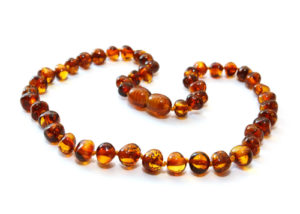
Another thing to steer clear of: homeopathic teething tablets that contain belladonna, a substance that can be toxic in high enough doses (it’s also known as “deadly nightshade” – yeah, we should definitely be giving that to our kids…).
In theory, the small amounts in each pill shouldn’t be a problem if parents adhere to the recommended doses, but laboratory testing confirmed that the precise amount of belladonna in any given tablet is inconsistent, meaning that even if you follow the directions exactly, parents can never be 100% certain about how much belladonna their child is getting.
The adverse incidents reported to the FDA following use of these tablets – 370 of them between 2006 and 2016 – are terrifying: babies have stopped breathing, turned blue, been airlifted to the hospital, and even died (10 children died). Um, no thanks. Oh yeah, and much like the rest of the world of homeopathy (no offense), there’s no scientific evidence that these work either.
Note: The Hyland’s brand teething tablets were implicated in the initial adverse effects, and the company pulled the product from the market. Since then, Hyland’s has since come out with a new (and renamed) product that does not contain belladonna. In theory you shouldn’t find any of the old tablets on the shelf, but just make sure you double check the label if you do decide to go this route for whatever reason.
Alcohol
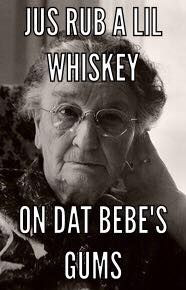
In the words of Dr. Stanley Alexander, the chairman of pediatric dentistry at Tufts University School of Dental Medicine, “First of all, children shouldn’t be consuming alcohol . . . Second, [alcohol] has no real numbing effect on the gums as the teeth are coming up.”
Damn, there goes that option.
To sum up, your home-remedies (cold stuff to chew on) seem like a safer bet than the old wives solutions. You can also buy a couple of teethers for when you need something at the ready. And, if you want to nurse well into (and even past) baby’s teething stage, there are tips and tricks you can use to prevent and/or stop painful biting.
In the meantime, know you’re in good company. If there’s one thing parents can universally commiserate on, it’s teething. Hang in there!